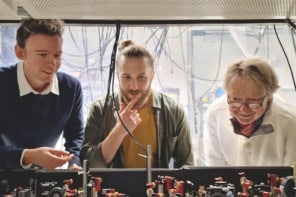Physicists in Germany and Hungary claim that ultracold atoms in an optical lattice could be used to simulate certain aspects of quantum chromodynamics (QCD) -- the theory that describes how quarks are bound inside protons, neutrons and other hadrons. They predict that by cooling atoms such as lithium-6 into a Fermi condensate, the atoms could be made to behave similarly to quarks. Although the technique has yet to be proved experimentally, it could shed new light on unsolved problems in QCD, which is notoriously difficult to simulate on a computer (Phys. Rev. Lett. 98 160405).
Fermi condensates are formed when particles with a half-integer spin number, known as fermions, pair up at very low temperatures and collectively fall into the same quantum state. They can be created by loading ultracold atoms into an “optical lattice”, which is an array of energy wells formed by crisscrossing laser beams. The strength of the interactions between the particles in the pair can then be “tuned” by applying a magnetic field to the lattice – an ability that allows physicists to simulate the pairing of electrons in high-temperature superconductors and other poorly-understood states of matter.
A team led by Walter Hofstetter from J. W. Goethe University, however, has thought of an altogether different application – using an optical lattice as a physical simulation of how quarks interact via the theory of QCD. Quarks are always bound together within hadrons as pairs or triplets according to their “colour”, which can be either red green or blue. Hofstetter’s team thinks that if an optical lattice were prepared containing ultracold fermionic atoms with three closely-spaced, “hyperfine” states, the states would be analogous to the three colours of quarks, and so the cold atom system could be used as a “toy model” of QCD.
To do this, the team suggests using lithium-6 atoms . Once cooled into a Fermi condensate , their interactions could be tuned to make the atoms strongly attract each other – comparable to the way quarks are bound, for example, in a proton.
“An experimental implementation of our model with cold atoms would be much more powerful than any numerical simulation on a classical computer, because quantum many-body systems quickly become very complicated,” Hofstetter told Physics Web. “It would be similar to the speedup of a quantum computer compared to a classical one for more specialized purposes.”
One particularly intriguing application of the model would be to study the change in the system from the Fermi condensate, “superfluid” phase at weak interactions to having three fermions tightly bound together in a “trionic” phase at strong interactions. This would be closely analogous to a phase transition thought to occur in QCD, in which quarks change from a “colour superconducting” state to a normally-bound, hadronic state depending on their density.
This will not be the first time that concepts from condensed-matter and particle physics have been exchanged – for example, the gaps between energy levels in superconductivity have been shown to be similar to those in nuclei excitations. “From this point of view the study of atoms in the optical trap has great potential,” Bogdan Wojtsekhowski, a particle physicist from the Thomas Jefferson National Accelerator Facility, told Physics Web. “However, I am sceptical about the connection between the trionic state [for atoms] and the QCD state [for quarks].”
Experimental groups at the University of Mainz in Germany and the Massachusetts Institute of Technology in the US are already considering implementing Hofstetter’s idea.



